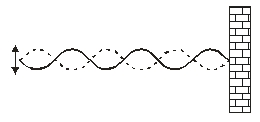A standing wave is created by oscillating a taut string at a frequency that corresponds to one of the resonant frequencies.The amplitude of the antinodes is very much larger than the amplitude of the oscillator.Does this violate the conservation of energy principle? Explain why. 
A) Yes,since E is proportional to amplitude squared.
B) Yes,since there is large kinetic energy of the string,and this is much bigger than the energy from the oscillator.
C) No,energy from waves does not obey the conservation of energy principle in the first place.
D) No,the energy at the antinodes builds up after the first few cycles,after which the dissipation due to friction equals the energy supplied by the oscillator.
E) Whether it obeys the conservation of energy principle depends on the tension in the string.
Correct Answer:
Verified
Q29: A string 2.0 m long has
Q30: A standing wave is shown in the
Q31: A string fixed at both ends is
Q32: A microphone is placed at the node
Q33: In a vibrating-string experiment,three loops are observed
Q35: A string of linear density
Q36: A string 2.0 m long has
Q37: The figure shows a standing wave in
Q38: The fundamental frequency of a vibrating string
Q39: Four pendulums are hung from a light
Unlock this Answer For Free Now!
View this answer and more for free by performing one of the following actions

Scan the QR code to install the App and get 2 free unlocks

Unlock quizzes for free by uploading documents